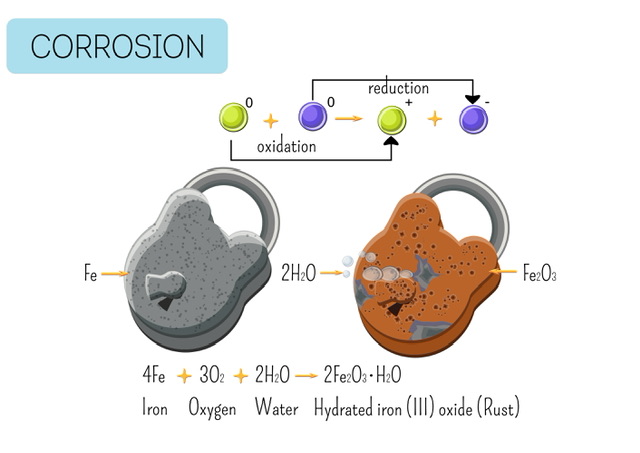We'll be back in a bit !
The system is currently undergoing a routine upgrade to ensure you get the best learning experience. The maintenance is expected to continue till 8:00 pm. Please check back later.
Thank you for your understanding!

Oxidation processes include corrosion and rusting. Corrosion, on the other hand, impacts a considerably larger variety of metals than rusting does, which is limited to iron. Corrosion, the oxidation of metals and nonmetals, leads to the breakdown of materials and the unintentional destruction of ecosystems. Rust is the result of the corrosion of iron and its alloy components. Rust and corrosion are both seen negatively, thus, measures are taken to stop them.
Rusting of Iron
Rusting occurs when iron or Fe-containing materials are oxidized. This takes place when oxygen and water are present. It's a slow process. Rust forms on iron objects over time. The oxidation of iron in the presence of oxygen and moisture produces a reddish-orange colored FeO.
Of the many hypotheses that attempt to explain rust, the electrochemical theory provides the most compelling evidence.
The concept is that the electrochemical cell formed by the rough surface of the iron stores ambient moisture containing dissolving air. Iron acts as an anode on the surface of this iron cell, entering the solution when its oxidation releases electrons. The cathode is an air-dissolved-in-water mixture that is used for reduction. The cathode readily accepts an electron, leading to the formation of OH-. The 2 ions combine and produce Fe(OH)2. Ferrous hydroxide is then oxidized to generate Fe(OH)3 .
Ferric hydroxide then forms a reddish-brown Fe2O3. xH2O.
One of the techniques to prevent rusting is:
Protection paint
Galvanization
Hold iron & steel things dry, clean, and away from air and moisture.
By putting on a shielding covering.
By substituting iron alloys for pure iron.
Corrosion is a chemical process in which the surface's chemical composition alters as a result of the presence of moisture and the action of oxygen. Like erosion, it occurs just on the surface. In addition, rusting occurs naturally. The procedure includes transforming the purified metals into stable oxides. Nonetheless, it does gradually weaken the metal over time. Both chemical and electrochemical reactions play a role.
Oxygen and sulfates are two examples of corrosive chemicals. This is a possibility in metals, ceramics, and polymers. In addition, this procedure might diminish vital material characteristics like structure, strength, attractiveness, etc. In the presence of atmospheric moisture, metals often deteriorate. The most common methods for protecting a surface against corrosion are passivation and chromate conversion.
When moisture with trace amounts of soluble salts clings to a steel surface, the electrochemical process may commence. Water contains a unique amount of soluble oxygen that can initiate the oxidation reaction, in which an iron loses electrons, which are acquired by oxygen itself; the dissolved salt traces in water provide the electrical link between the oxidizer (atmospheric oxygen) and the substrate being weathered (metallic iron beneath). This initially causes iron to disintegrate. There are two sections to the reply:
Fe2+ ions combine with the hydroxyl ions OH- generated favor the precipitation of insoluble Iron(II) hydroxide, Fe(OH)2, a greenish substance. This can further oxidize Fe2+ ions to Fe3+ ions.
Iron(III) hydroxide is a gelatinous, rust-like substance.
The following measures can be taken to prevent corrosion:
Barrier coatings like paint, gelatin, etc.
Galvanization
Cathodic protection.
Corrosion and rancidity both involve oxidation, although they serve different purposes. When fats and oils in food spoil due to oxidation, the item acquires a rancid flavor and odor. Food storage in sealed containers and the use of antioxidants can prevent this.
Radicals are produced on dietary items due to the initiation reaction sparked by environmental elements, including heat and air. An atom, molecule, or ion with an unpaired electron is called a radical. Chemical radicals are particularly reactive due to their unpaired electrons.
In the propagation reaction, peroxides are produced as a result of atmospheric oxygen. With the help of further reactions with unsaturated fatty acids, these peroxides create new radicals.
Termination Reaction: In the third stage, two radicals combine to form a new single bond.
The following methods can be used to prevent rancidity.
By using inert gases in packaging
By using oxygen scavengers.
By refrigeration of food materials.
By storing food materials in a hot-dip dark place.
It's safe to say that rusting and corrosion are two sides of the same coin. As rust and corrosion are both results of oxidation processes. Nevertheless, there are a few subtle distinctions among them. Corrosion can be caused by chemical coatings or by exposure to air and moisture. Iron and steel develop a rusty, orange-red coating due to a chemical reaction. The substance oxidizes. The primary distinction between corrosion and rusting is that the former may be induced by chemicals while the latter cannot (although some chemicals can speed up the rusting process).
Foods that contain butylated hydroxy anisole are less likely to go bad quickly. A combination of the two isomers 2-tert-butyl-4-hydroxyanisole and 3-tert-butyl-4-hydroxyanisole, butylated hydroxy anisole is an antioxidant.
Temperature affects the rate of corrosion. Corrosion rates vary with temperature. When metal items, machinery, or structures are operating at high temperatures, more care must be taken to prevent damage from rust and corrosion, which are exacerbated by the higher temperatures.
The rate of corrosion is proportional to the concentration of acid in the solution, as corrosion slows down when the pH rises. When the nitric acid concentration in the corrosion solution rises, so does the rate of corrosion.
